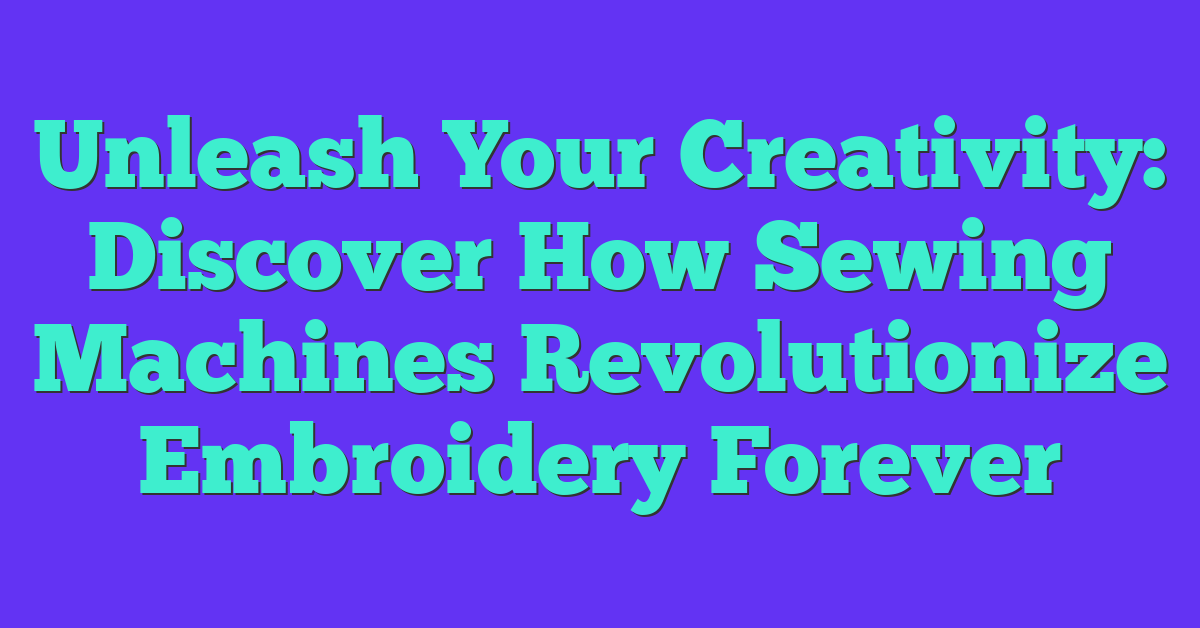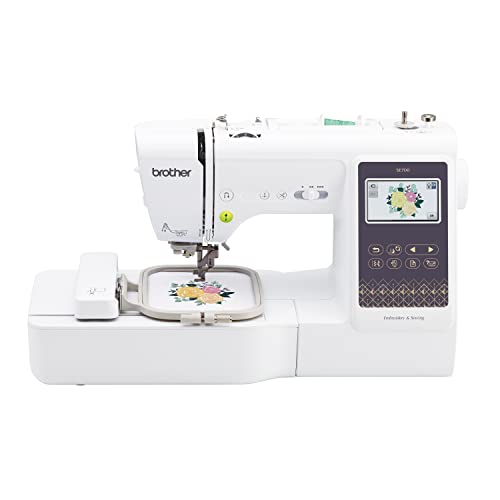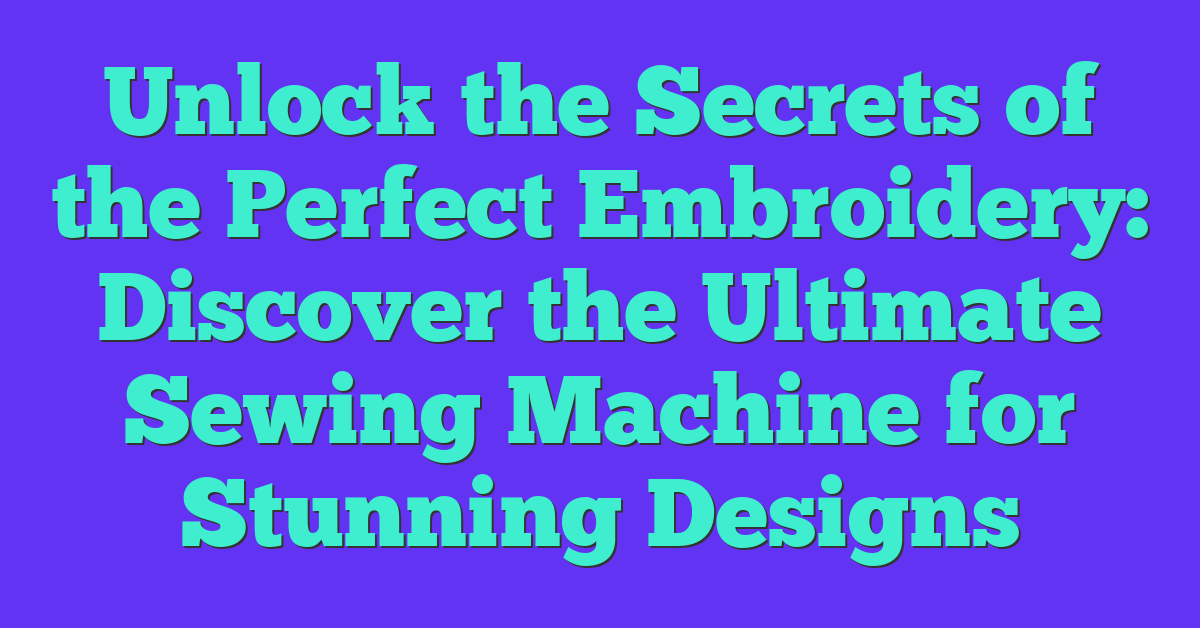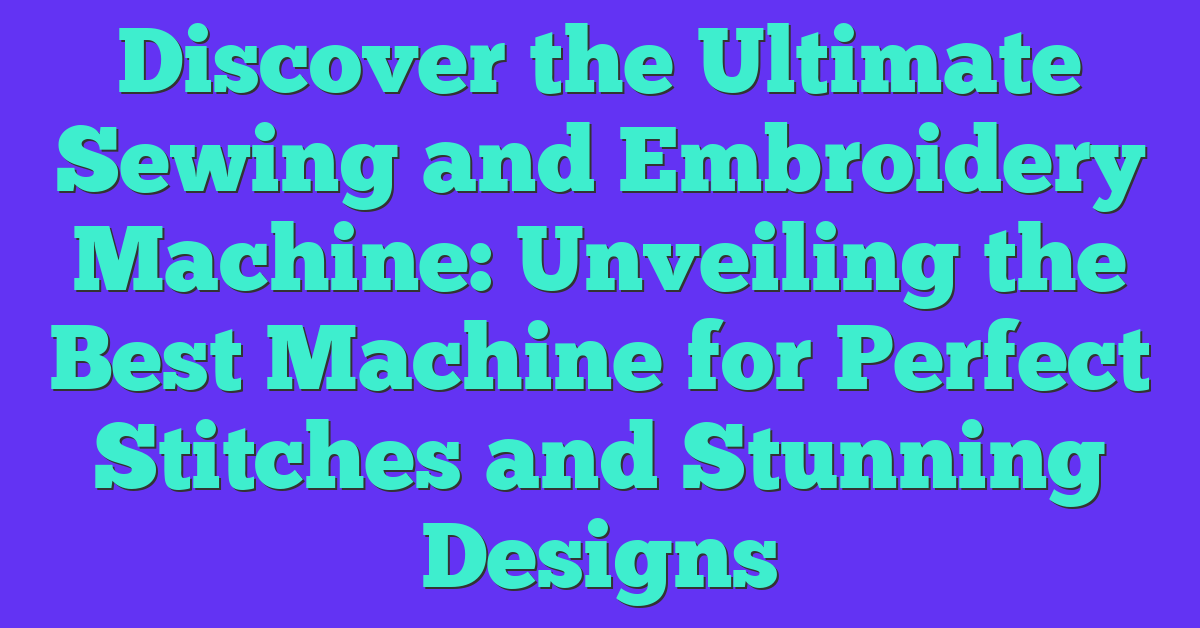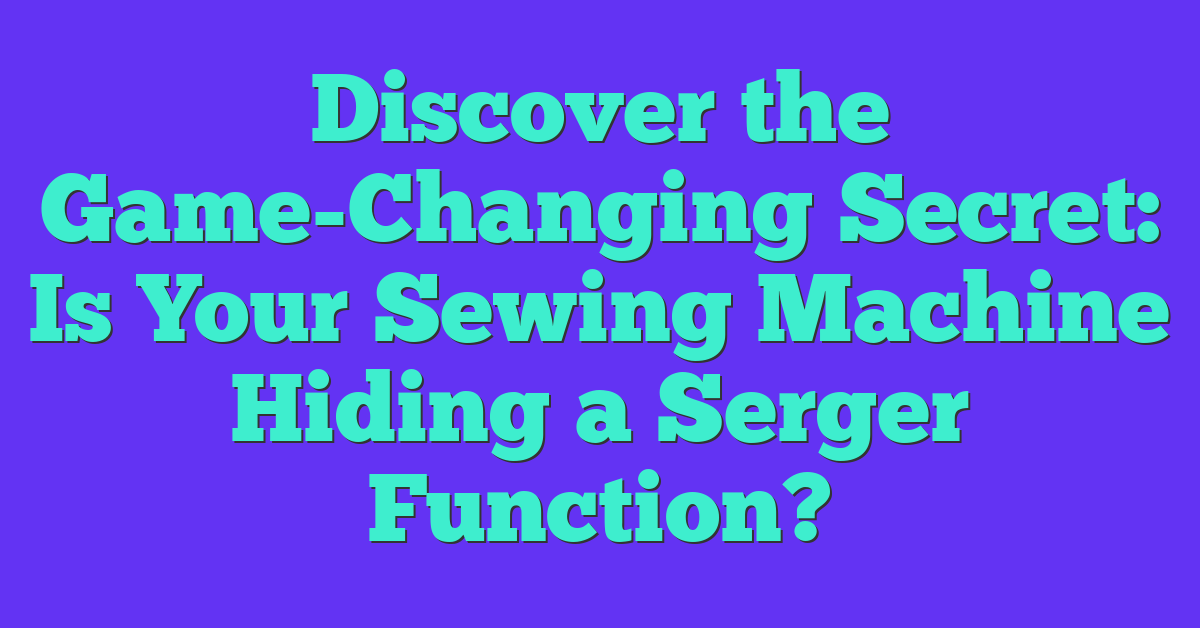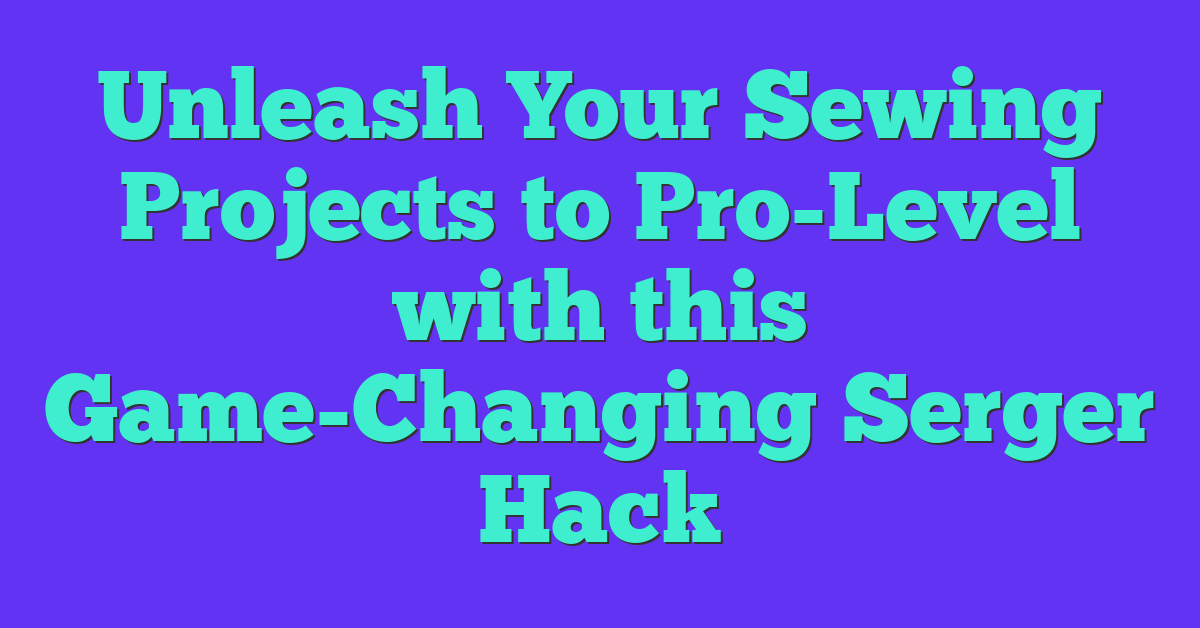Are you curious about the capabilities of sewing machines? Specifically, can they do embroidery? Well, you’ve come to the right place! In this article, we’ll explore the exciting world of sewing machines and their embroidery functions. Whether you’re a beginner or an experienced sewist, understanding the potential of your sewing machine can open up a whole new realm of creative possibilities. So, let’s dive in and discover if sewing machines can indeed do embroidery!
Embroidery has long been a popular and beautiful form of embellishment. Traditionally, it required intricate hand-stitching skills to achieve stunning designs. However, with the advancement of technology, sewing machines have evolved to include embroidery functions. This means that you can now create intricate and professional-looking embroidery designs using a single machine. If you’ve ever wondered if sewing machines can do embroidery, you’ll be thrilled to learn about the exciting features and possibilities that modern machines offer.
Nowadays, many sewing machines come equipped with built-in embroidery capabilities. These machines feature specialized embroidery stitches, designs, and even computerized options to create intricate patterns. With the ability to select from a wide range of embroidery designs and adjust settings to your liking, sewing machines have become a versatile tool for both sewing and embroidery enthusiasts. So, if you’re wondering if your sewing machine can do embroidery, keep reading to find out how you can explore this fascinating craft right at home.
What is Embroidery?
Embroidery is a beautiful and intricate form of needlework that can add a touch of elegance and personality to your sewing projects. It involves decorating fabric or other materials with decorative stitches and patterns, creating stunning designs that can elevate the overall look of any item.
Traditionally, embroidery was done entirely by hand, requiring hours of meticulous stitching and a skilled hand. However, with modern advancements in technology, sewing machines have now evolved to include embroidery functions. This means that you can combine the convenience and speed of a sewing machine with the artistry and intricacy of embroidery.
Embroidery machines are specially designed to automate the process of stitching intricate designs onto fabric. Some sewing machines come with built-in embroidery capabilities, allowing you to create beautiful designs with just a few clicks. These machines usually have a variety of built-in stitches, patterns, and fonts that you can use to embellish your projects. Additionally, they often come with a computerized interface, giving you more control over every aspect of your embroidery.
With a sewing machine that has embroidery capabilities, you can create a wide range of designs, from simple monograms to intricate and detailed patterns. These machines make it easier than ever to personalize your creations and make them truly one-of-a-kind. You can use embroidery to enhance garments, home decor items, accessories, and even gifts for your loved ones.
Remember, not all sewing machines have embroidery capabilities, so if you’re interested in exploring the world of embroidery, make sure to check if the machine you’re considering has this feature. Investing in a sewing machine with embroidery capabilities can open up a whole new realm of possibilities and take your sewing projects to the next level.
Types of Embroidery Machines
When it comes to embroidery machines, there are a few different types available on the market. Each type has its own unique features and capabilities, so it’s important to understand the differences before making a decision. Here are some of the most common types of embroidery machines:
- Mechanical Embroidery Machines: These are the traditional, non-computerized machines that have been around for decades. They require manual adjustment of settings and usually have limited built-in stitches and designs. While they may lack some of the advanced features of modern machines, they can still produce beautiful embroidery with a little bit of practice and skill.
- Electronic Embroidery Machines: These machines are a step up from mechanical ones, as they have electronic controls and displays. They often come with more built-in designs and stitches, and some even have USB ports or card slots for importing additional designs. These machines are generally easier to use and offer more versatility than their mechanical counterparts.
- Computerized Embroidery Machines: The pinnacle of embroidery technology, computerized machines offer a wide range of features and capabilities. They have large, color touchscreen displays for easy design manipulation and editing. These machines often come with extensive built-in design libraries and may even allow you to digitize your own designs. Some higher-end models can connect to the internet for downloading new designs or updating software.
- Embroidery-Only Machines: As the name suggests, these machines are designed specifically for embroidery and do not have sewing functions. They are a great option for those who are solely interested in embroidery and don’t need a machine for regular sewing tasks. Embroidery-only machines often offer a larger embroidery area and may have more advanced features dedicated to embroidery.
- Combination Sewing and Embroidery Machines: If you want the best of both worlds, a combination machine is the way to go. These machines allow you to switch seamlessly between sewing and embroidery functions, offering convenience and versatility. They usually have a wide range of built-in stitches, decorative stitches, and embroidery designs, making them a great all-in-one option.
Can Sewing Machines Do Embroidery?
When it comes to your sewing machine, you might be wondering if it’s capable of adding some embroidery magic to your creations. Well, the good news is that many sewing machines these days are equipped with embroidery capabilities, allowing you to go beyond basic stitches and add beautiful designs to your projects. So, let’s dive into whether your sewing machine can do embroidery and what you need to know about it.
Embroidery Capabilities
Not all sewing machines have embroidery capabilities, but the ones that do offer a whole new level of creativity. With the right machine, you can easily switch between regular sewing mode and embroidery mode, bringing a world of decorative possibilities to your fingertips.
Different Types of Embroidery Machines
There are different types of embroidery machines available, each with its own unique features and capabilities. Let’s take a quick look at a few of them:
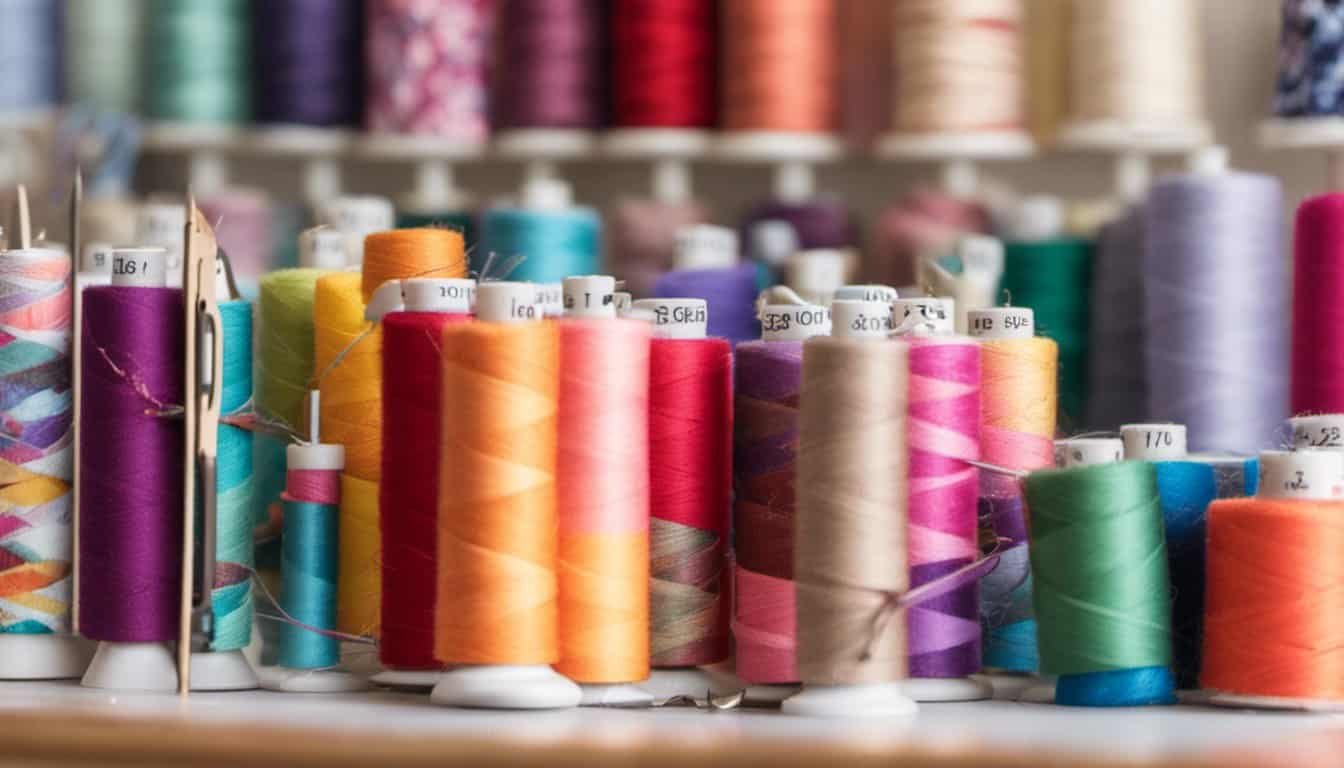
- Mechanical Embroidery Machines: These machines use knobs and dials to control the embroidery process. While they may have limited design options compared to electronic or computerized machines, they’re a great option for beginners or those on a budget.
- Electronic Embroidery Machines: These machines offer more versatility with touch screens and pre-programmed designs. They typically have a larger embroidery area and allow you to customize and edit designs.
- Computerized Embroidery Machines: These advanced machines use software and USB connectivity to import and digitize embroidery designs. You can create your own designs or choose from a vast library of pre-made ones.
- Combination Sewing and Embroidery Machines: As the name suggests, these machines combine the functionality of both sewing and embroidery. They offer the best of both worlds, allowing you to sew garments and embroider intricate designs.
Considerations Before Investing
Before investing in a sewing machine with embroidery capabilities, there are a few things to consider. First, think about the type of projects you want to work on and the level of detail you desire. Additionally, budget, space, and ease of use are important factors to take into account.
Advantages of Using a Sewing Machine for Embroidery
Embroidery is a fantastic way to add a personal touch to your sewing projects. And did you know that sewing machines can also do embroidery? It’s like having two machines in one! Let’s explore the advantages of using a sewing machine for embroidery:
1. Versatility: With a sewing machine that has embroidery capabilities, you can switch between regular sewing and embroidery projects seamlessly. You’ll have the flexibility to create a wide range of items, from simple garments to intricate monogrammed designs.
2. Time efficiency: Sewing machines with embroidery capabilities are designed to streamline the embroidery process. They come with automatic features and built-in designs, saving you valuable time. You can easily adjust the settings to achieve the desired stitch length, width, and density, making your embroidery projects efficient and beautiful.
« Discover the Ultimate Easiest Pattern for Sewing Face Masks – Unleash Your Creativity and Protect Yourself in Style
Shocking Reasons Behind Sewing Bee’s Surprising Move Revealed – Find Out the Secret Strategy Behind the Shift »
3. Cost-effective: Investing in a sewing machine with embroidery capabilities is a cost-effective option compared to purchasing a separate embroidery machine. You’ll be able to explore the world of embroidery without breaking the bank. Plus, you’ll save valuable space in your craft room!
4. Creative freedom: Embroidery machines offer a wide range of decorative stitches, fonts, and designs. You can embellish your projects with custom monograms, intricate floral motifs, or even your own unique creations. Let your creativity flow and make your sewing projects truly one-of-a-kind.
5. Easy to learn: If you’re already familiar with sewing machines, transitioning to using one for embroidery will be a breeze. Most sewing machines with embroidery capabilities come with user-friendly interfaces and tutorials. You’ll be embroidering beautiful designs in no time!
6. Perfect for beginners: Sewing machines with embroidery capabilities are great for beginners who want to venture into embroidery. You can start with pre-programmed designs or use the machine’s connectivity options to import designs from your computer. It’s a fantastic way to learn and practice embroidery without feeling overwhelmed.
Limitations of Using a Sewing Machine for Embroidery
While sewing machines with embroidery capabilities offer a wide range of benefits, it’s important to be aware of their limitations as well. Here are a few key factors to consider when using a sewing machine for embroidery:
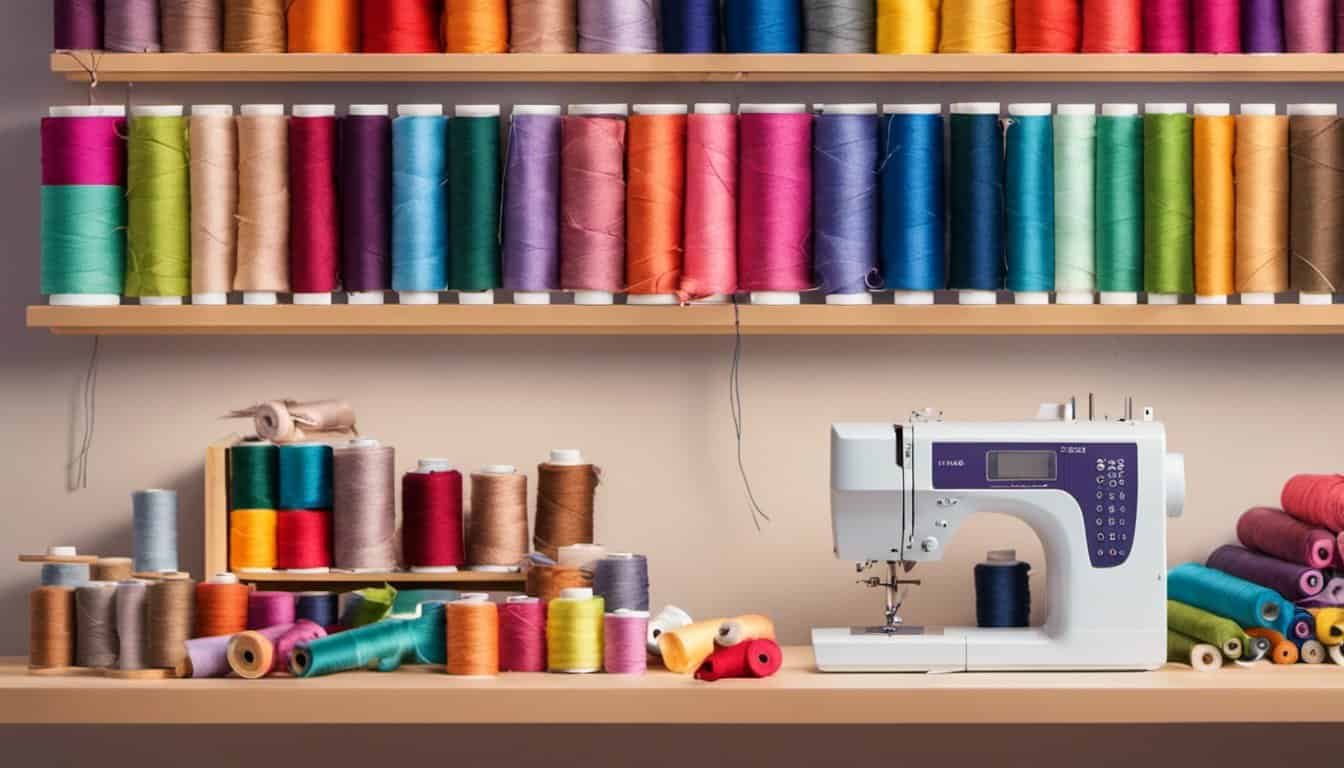
- Design Size and Complexity: One of the main limitations is the size of the embroidery design that a sewing machine can handle. Most sewing machines have a limited embroidery field, usually around 4×4 inches or 5×7 inches. This means that larger or more intricate designs may not fit within the machine’s embroidery area, requiring you to either resize the design or consider alternative options.
- Embroidery Speed: Sewing machines are primarily designed for sewing, and while they can embroider, the speed at which they do so may be slower compared to dedicated embroidery machines. If you have a large embroidery project or need to produce multiple items with intricate designs, a dedicated embroidery machine might be a better choice to save time.
- Limited Built-in Designs: While sewing machines with embroidery capabilities come with built-in designs, the number and variety of these designs are limited compared to dedicated embroidery machines. If you’re someone who enjoys exploring a wide range of design options, you may find yourself wanting more choices beyond what your sewing machine offers.
- Thread Changes: Sewing machines typically have a single needle, which means that if your embroidery design requires multiple colors, you’ll need to manually change the thread each time. This can be time-consuming and may require careful attention to detail to ensure smooth transitions between colors.
- Advanced Functions: Some advanced embroidery techniques, such as 3D embroidery or free-motion embroidery, may not be possible to achieve with a sewing machine alone. These techniques often require additional tools, attachments, or more specialized machines.
Despite these limitations, sewing machines with embroidery capabilities still provide excellent versatility, creative freedom, and cost-effectiveness for many hobbyists and beginners. By understanding and working within the limitations, you can still achieve impressive embroidery results using a sewing machine.
No conclusion paragraph.
How to Do Embroidery with a Sewing Machine
Embroidery is a beautiful and intricate craft that adds a personal touch to your creations. If you already have a sewing machine, you’ll be pleased to know that you can use it for embroidery as well. Here’s how to get started with embroidery using your sewing machine:
1. Choose the Right Needle and Thread
Before starting your embroidery project, make sure you have the right needle and thread. Use a sharp needle with a small eye for delicate fabrics, or a larger needle for heavier fabrics. Select a thread that complements your fabric and embroidery design.
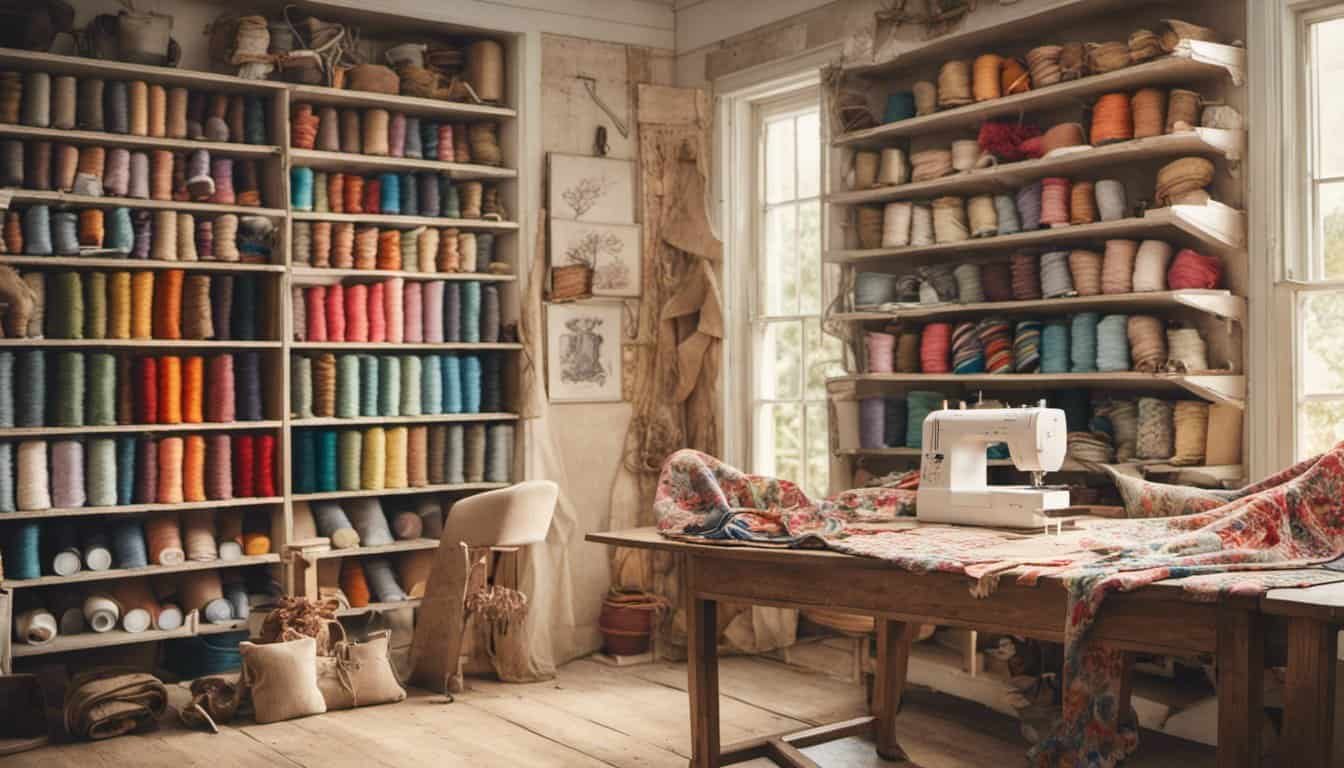
2. Prepare Your Fabric
Ensure that your fabric is clean and free from any wrinkles or creases. Hoop your fabric tightly in an embroidery hoop. This will provide stability and help you achieve precise stitches.
3. Select the Design
Many sewing machines with embroidery capabilities come with built-in designs and fonts. You can choose from a variety of motifs, monograms, and decorative stitches. If you want to get more creative, you can import designs from your computer using compatible software.
4. Set Up Your Machine
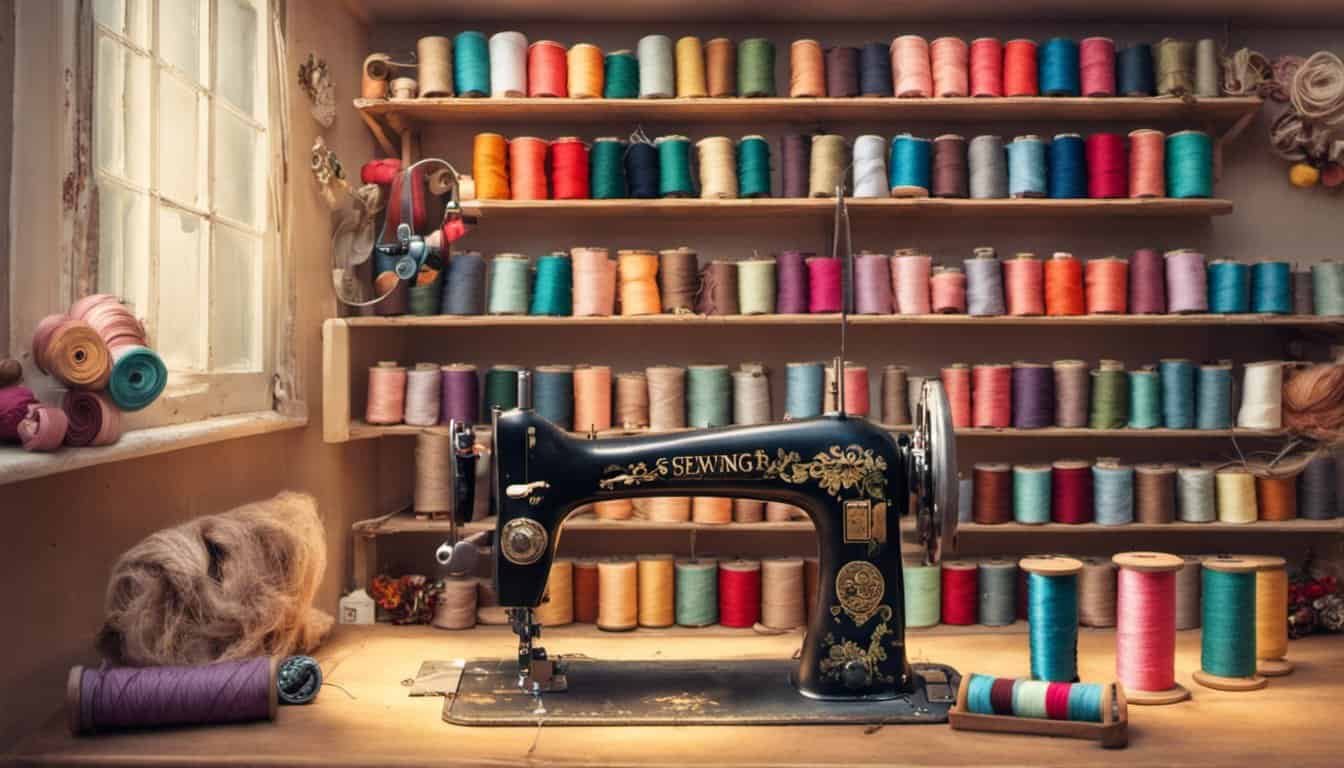
Follow your sewing machine’s manual to set up the embroidery function. Attach the embroidery foot and thread the machine with your selected thread color. Adjust the tension and stitch settings according to your fabric and design.
5. Start Embroidering
Position your fabric under the needle, aligning it with the design’s starting point. Use the machine’s controls to guide the needle along the design. As the machine stitches, make sure to keep the fabric and hoop steady to prevent any unwanted movement.
6. Change Threads and Colors
If your design requires different thread colors, you’ll need to manually change them during the embroidery process. Follow your machine’s manual to learn how to do this smoothly, without damaging your design.

7. Finish and Remove the Hoop
Once you’ve completed your embroidery, carefully remove the hoop from your fabric. Trim any excess thread and give your embroidery a final press to remove any wrinkles.
Conclusion
With their versatility, time efficiency, cost-effectiveness, and creative freedom, sewing machines with embroidery capabilities are a fantastic option for both beginners and experienced crafters. These machines allow for seamless switching between sewing and embroidery projects, come with automatic features and built-in designs, and offer a wide range of decorative stitches and fonts.
Investing in a sewing machine with embroidery capabilities not only saves you money compared to purchasing a separate embroidery machine, but it also saves space in your craft room. Transitioning to using a sewing machine for embroidery is easy, especially if you’re already familiar with sewing machines. Beginners can start with pre-programmed designs or import designs from their computer, making it a great option for those just starting out.
While there are limitations to using a sewing machine for embroidery, such as the size and complexity of designs, slower embroidery speed, and limited built-in designs, these machines still provide excellent versatility, creative freedom, and cost-effectiveness. Just remember to choose the right needle and thread, prepare your fabric properly, select your design, set up your machine correctly, embroider with precision, change threads and colors as needed, and finish and remove the hoop carefully.

So go ahead and explore the world of embroidery with a sewing machine that offers both functionality and creativity!

